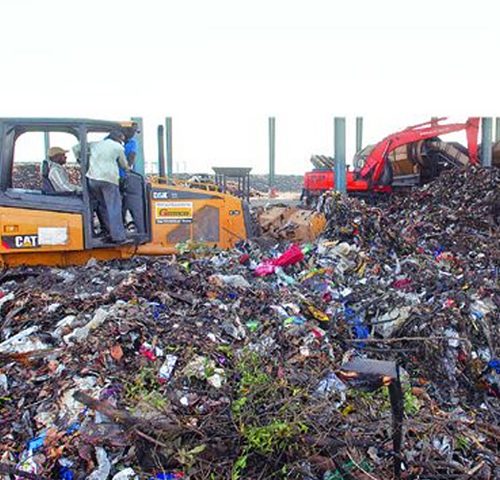What are your worst nightmares made of? Getting lost on a mountain of filth or drowning in a lake of black ooze? This is not a scene from a Stephen King novel. This is the reality of Jawahar Nagar, the 300-acre dump site that receives all the garbage of Hyderabad.
Jawahar Nagar is a village located in Medchal district, which falls under Shamirpet mandal. The Greater Hyderabad Municipal Corporation (GHMC) has its dumpsite located in this village and about 3500 metric tons of waste generated in Hyderabad is disposed over here on a daily basis.
Drive past Trimulgherry and you start to get a whiff of the stench that awaits you down the road because most of the trucks that transport the garbage, pass through here. Once you reach the suburbs of Kapra, Keesara and Dammaiguda, the filth, insects and stench becomes unbearable. The health of these helpless residents of Jawahar Nagar are clearly at stake.
This dump site has been in active use since a decade and has now reached saturation level. The problems faced by the residents of this locality have been getting worse every year and they have now reached a point where they are afraid to even drink water from their own homes. The air here is impossible to breathe and the ground water has been contaminated by the leachate – the fluid from rotting garbage – that is seeping into the ground and polluting the ground water. Water filled from the taps here have an oily layer on top. Officials from the groundwater directorate claim that the groundwater here is full of harmful chemicals. The amount of Total Dissolved Salts (TDS) in the groundwater present in the water can cause kidney stones and heart diseases. There is also abundance of chemicals such as magnesium, which can cause gastric problems.
The contract of managing this dump site was awarded to the Ramky group which is responsible for carrying out the capping in this area. Capping is a scientific method by which the garbage is covered in such a way that the leachate does not get into the ground, but the contaminated ground water is testimony to the fact that this is not being done. They do not even have a leachate treatment plant that can handle the garbage of this magnitude so the oozing liquid just seeps into the ground. This liquid is so toxic that it dissolves the stones that it comes in contact with, so we can only imagine what it can do to the health of a person. When questioned, both GHMC and Ramky were evasive with their answers.
Ramky has been served a notice by the Telangana State Pollution Control Board for multiple violations of environmental laws and causing health hazards. The state government is thinking of taking over the management of the dump and scrapping their contract after reviewing their MoU.
In addition, the Chief Minister has also instructed the GHMC Commissioner Somesh Kumar to locate and develop more dumping yards around the city. Since, finding a large land area in Hyderabad district that is at least 200 acres is hard, the government is focusing on the neighboring districts of Ranga Reddy, Medak, Mahbubnagar and Nalgonda for creating new dump yards. This is still hard because obviously nobody is interested in having a dump yard close to their locality.
Before any of these actions are implemented, the government needs to check the legalities of the agreement with the Ramky group. It also has to streamline the collection and transportation of garbage. About 2,500 additional rickshaws and vehicles need to be procured for effective transportation of the garbage and the door-to-door, two-bin garbage collection system should be strictly enforced.
Nearby slaughter houses have got into habit of disposing raw animal carcasses without proper treatment. The treatment plant of the Ramky group is unable to treat such waste so the slaughter houses should be made to treat their waste before they pass their garbage to the dump yard.
The GHMC has plans to take over the work of the Ramky group and cap the dump within 102 acres of land earmarked for the same. The area allocated for the active capping is 74.66 acres and passive capping is 28 acres. GHMC will bear the Rs 33.86 crore required for the passive capping and Rs 102.97 crore for the active capping. Once the capping is concluded, the area can be utilized to set up solar or wind power plants.
As much as we blame the state government and the Ramky group for their negligence, we as citizens are equally at fault because we are the ones generating such humongous amounts of garbage. About 3500 tons of garbage is generated every day in Hyderabad. The average adult elephant weighs anything from 3 to 7 tons, so the city of Hyderabad generates garbage equivalent to the weight of 700 elephants every day! Everyone will agree that this is an alarming amount of garbage.
We need to reduce the amount of garbage we produce and reduce the load on the dump yard. This can be achieved in two ways:
1) Reduce the use of plastics and recycle and reuse them as much as possible so that they do not end up in the garbage.
2) Reduce the amount of kitchen garbage by using kitchen scraps to make compost at home. Those with a garden can create a compost pit in one corner of their garden while those living in apartments can use the compact composting bin that is available in the market these days.
It is imperative that private citizens, the government and corporates come together to solve this urgent crisis that is facing Hyderabad today. The health of our citizens and the environment of our beloved city is at stake.




